Second caveat is that this is a Work In Progress!
Borders
I get a lot of questions about crossing borders. In fact, it's one of the most popular questions I get. However, the answers are simple. Are borders "hard"? No. Time consuming? Yes.
My advice is to approach a new border crossing as an all day event. Try to get there in the morning, plan to spend all day and be pleasantly surprised when you get through early. The fact is is that every border is different and each will require a number of additional steps with a vehicle above and beyond immigration.
Essentially at each border you need to import your vehicle and yourself. Start by going to immigration and then inquire about what to do with the motorcycle. Almost all borders will require you to go to immigration first.
Most countries require a temporary vehicle import permit (TVIP)...this is the main thing you are trying to acquire at the border for your motorcycle. Some countries require insurance, when it is required there is usually a place to purchase it at the border. Some countries require photo copies of things like: your title, license, passport, entry stamps, etc. When copies are required there is always a copy place nearby...don't bother making a bunch of copies before you leave because you will probably need a copy of the stamp you just got anyway.
When you leave a country usually you will need to turn in your TVIP. Sometimes there is a deposit (Mexico) and you will want to get your money back as well.
Note: This info pertains to American countries that do not require you to pre-apply for a visa. Some countries like Brazil and now Venezuela require you to pre-apply for a visa and you cannot get this at the border. Some countries (e.g. in Africa) require what is known as a "Carnet de Passage" which is a whole other thing.
Luggage
What to Bring
Clothing
As little clothing as you are comfortable bringing. For me I bring 5 pairs underwear, 5 pairs socks, 1 pair jeans, 1 sweatshirt, 3 t-shirts, 1 button down, 1 pair long underwear, bathing suit, 1 sport shorts, 1 towel. I prefer synthetics so I can wash things in the sink and have them dry by morning.
Tools
I suggest learning and living with your bike for at least a few months before traveling with it. In this time do all your own maintenance and repairs and do it with the toolkit you plan to bring. Anytime you need a tool that's not in your kit...add it.
Obviously have at least what you need to change your oil and a flat tire. My entire kit can be found on the gear page.
Electronics
I carry a laptop and a point and shoot. Beyond that I like carrying a USB battery for those days when there is no electricity and you want to charge your camera, phone, etc.
Bike Stuff
I really like having a small, cheap cover for the bike. It's useful for rain, obviously but also piece of mind and security.
You'll also need spare oil, air filter oil, chain lube and WD40. I also carry a small bottle of dish detergent to clean my air filter.
How to Pack
Essentials toolkit in tank bag. Bike stuff and not often needed things in lockable luggage on the bike. Clothes, toiletries, laptop, daily use things in easily to remove waterproof backpack.
Why?
You will want to be able to get to your tools quickly and easily. For things like changing a tire, oil, chain, etc, these tools can be harder to get to. But for the small things and the quick fixes you'll be glad time and time again if your tools are handy.
Every day you will be packing and unpacking. Going to a new hostel, motel, hotel, camp sight, etc. Most of the time you will want to find secure parking for your bike. Most of the time you just need to grab your backpack and tank bag off the bike. It sucks to have to haul heavy luggage around when it's hot and you are in full gear day in and day out.
I also like to keep my flip flops and sport shorts in my camel pack. That way I can ditch my moto gear and be comfortable without having to touch my pack. I can also load up my bike in the morning before gearing up.
Maintenance and Repairs
Oil Changes
This was my biggest concern setting off and it actually took me a little while to figure out. What oil is available? Where can I change my oil?
There are many answers to this. There are shops everywhere that will change your oil for you. If you have a bike that doesn't need special oil then it's easy. If you are on a bike that can go 5k miles between changes then it's easy.
What if you are on a bike like a KTM 690 that likes new 10w60 Motorex CrossPower every 2k miles? I have found that Motul 20w50 7100 Full Synthetic is easy to find just about everywhere in Latin America. It's important to choose an oil and stick to it that way your bottle to top up matches your oil and also makes future oil changes easier.
Invest in cleanable oil filters if they are available for your bike. Clean in some gas and never have to worry about finding/carrying oil filters.
Buy a gallon of water...fill your camel pack...cut it in half...drain pan. Refill empty oil containers with the drained oil and leave at a shop. #roadsideoilchange
Tires
Larger tires are scarce in Latin America and often wildly expensive. In the larger cities in South America you can find Heidenau's and premium imported tires but they are well over $300 a set. You can find Pirelli tires (from Brazil) everywhere cheap...MT60's, MT90's, etc.
Repairs
There are a ton of shops ("Taller") in Latin America. And unlike the U.S. they will let you work on your own bike using their tools. So if you need to do some extra maintenance type things like replace your fork seals (or whatever) chances are you can find a shop with a good mechanic and tools to help you do it yourself.
Spares
This is really about knowing your bike. What are the wear parts on your bike? Took me a while to figure it out on the 690. Now I carry a fuel injector, bearings, water pump seals, spark plug, rocker arms, etc (full list can be found on the bike page).
Route Planning
Where to eat?
Easy and cheap everywhere. Look for "menu del dia"'s. Places that have a fixed menu at a cheap price. Very popular in Latin America.
Where to stay?
Backpacker hostels are a rip off in Latin America. I guaranty you that 95% of the time there is a hotel/hostel/hospadaje nearby that will give you a private room for less than your backpacker hostel dorm bed. Only go to the backpacker hostels when you want to meet other travelers.
Planning ahead?
Easy, don't.Gear
Remember what your mom used to say, "dress in layers!"Being comfortable in your protective gear in all weather conditions is important. You will be less tempted to ride without gear.
You will get wet! Make sure your rain protection is top notch and easy to put on and take off. Make sure you have good solution to keeping your luggage dry as well.
Choosing a Bike
Light vs Heavy Bike
This falls strongly into the category of "to each their own". However my opinion is, the lighter the better. The lighter bike will allow you to go more places. It will be more fun on a daily basis. You'll be able to pick it up when you fall...and you will fall.
If however, you want to go from Alaska to Ushuaia two up in 3 months take a big bike because you aren't going to have time get off the highway anyway. Or perhaps you want to hit all the backpacker, touristy spots and you want to take the bus routes to get there. Or maybe you hate dirt riding.
I think it comes down to the ratio of importance of riding vs traveling. For me it's all about the riding. Seeing fun touristy stuff along the way is a bonus but the ride is the trip. If for you it's about travel and a motorcycle is a more appealing mode of transport than a bus then perhaps a bigger bike will be more comfortable and nice for you.
Reliable vs Fun
Do you take the KLR or the KTM? This was my dilemma and it came down to this. What will I have more fun on? If I am riding everyday for 4, 6, 12 months then I want it to be on the most fun machine I can. My advice is ride the most fun bike you can afford.
Also be wary...just because it's a popular bike from a popular manufacturer in the states doesn't mean it is everywhere and it may still be hard to find parts. The benefit of KTM is that they have limited models and lots of shared parts among them. So if you find a KTM dealer you may be more likely to find your part then you will be for your Yamaha at a Yamaha dealer.
Costs
I spend between 1000-1500 dollars a month not including extra expenditures like dive trips in Galapagos or larger bike repairs. I stay in hostels and hotels mostly and do not camp anymore. I try to stay around $10 or less for a room. I don't do many touristy things that cost money (e.g. tours, museums, activities, etc). I don't drink much and I almost always look to find cheap food.However, you can do it much, much cheaper. There are young people I meet that stop and work in places for a time waiting tables, working on hostels or even street performing. There are programs called workaways where you can live and eat in exchange for a few hours of work a day. You can also volunteer at hostels to stay for free. While these last two options don't really allow you to travel more they are a good option if you want/need to stop in a place for a while. There are also opportunities to camp for free, in many places it can be difficult to find but if you are willing to talk with locals I've met people that camp in churches and schools and town squares.
Safety
Everyone will say their own country and their neighboring country is more dangerous than it actually is. Especially people that aren't currently residing in their country. The U.S. thinks Mexico is dangerous, Mexico thinks Guatemala is dangerous, Guatemala thinks El Salvador is dangerous and so on.
Locals think it's impossible to navigate their roads. And especially if you are heading off into remote parts they will almost always tell you not to go and that it's too dangerous.
My thinking is this. If you don't know specifically about a place then you must consider the entirety of it as unsafe. Example. "Mexico is dangerous." This is not a false statement. However, not all of Mexico is unsafe. Therefore, if you don't know which parts are safe or unsafe then you have to consider all of Mexico unsafe. When you start traveling in Mexico you begin to learn what parts are safe and what parts are not so safe.
Road Safety
This is a whole different animal. The roads are of varying quality and condition. Guardrails are scarce as well as road maintenance. Sometimes half of a lane will be covered or fall because of a landslide and it won't get fixed...they will just paint a white line around it.
Animals: dogs, cattle, wildlife, etc are everywhere.
Cars will often not have working lights. Turn signals aren't used either but horns are used prolifically.
I could go on and on about the dangers of the roads here. However, when it comes down to it, the speeds are slower and everyone absolutely must pay attention all the time. Also, outside of the cities, there is less traffic.
Safety Tips
Be smart.
Don't ride at night.
Listen to your senses...you can tell when you are where you shouldn't be...you will get a not so welcoming vibe.
Don't wander home drunk at 3am. Don't buy drugs. (Most all of the stories I've heard of tourists having problems occurred during these two events once you get the truth.)
Don't ride at night.
Listen to your senses...you can tell when you are where you shouldn't be...you will get a not so welcoming vibe.
Don't wander home drunk at 3am. Don't buy drugs. (Most all of the stories I've heard of tourists having problems occurred during these two events once you get the truth.)
Bribes
I often get this question, "how often do you have to bribe police/officials/etc". The answer is, "not very often". It is not wrong to say the bribe culture is very much alive here. And unlike the US the bribes start at the bottom and go up. For example, I once had a driver put a bill in the folder with his vehicle paperwork, stop at a police station unsolicited, get out and hand the cops the folder. I asked him about it...he said that way he never has any problems.
The thing is that the cops aren't bad people. They take bribes because that's part of how they make their money and it's just how things work. If you think about it like "tipping" instead of giving a bribe then it becomes less aggravating. In the US we tip wait staff because it's expected and because it's expected restaurants will pay their waitstaff less because they can still hire people at low salaries and because it's so engrained in our culture there are differences in the minimum wage laws when it comes to waitstaff. So...this.
When a cop stops you and you did something wrong he'll (I say he because I've never had to offer a bribe to a woman cop) usually give you an opening to offer a bribe. He'll say that he has to write you a fine, he has to take your paperwork away, you have to go to the court/police station/etc tomorrow to pay the fine and get your paperwork back. You say, "can I pay the fine right now?". He responds with, "no". You ask again. Then he'll say, "maybe but it's more expensive." You hand him what you think will do the trick. Before all this he will be very nice and friendly. Never has a cop used intimidation on me...it's always been friendly and kind and matter of fact.
If you did nothing wrong, or you think you did nothing wrong and he still won't let you go then you just have to wait. Time can get you out of a bribe/fine. Maybe you'll have to wait for an hour, maybe longer. The cops will usually start by taking your registration and your license away (I never give them my passport and usually they don't ask). Then they will talk to you and if it's not going anywhere they will leave...stop more people...and come back. This can go on for a while.
All in all, I have been stopped dozens of times at random check points doing nothing illegal and never had any problems, they let me go right away and I didn't need to pay anything. I have been stopped for speeding and other traffic violations a couple times and had to offer bribes of varying amounts. I got stopped a couple times for bogus things and had to wait it out. The borders are very official and I don't think bribes will fly. I had a problem with missing paperwork at the Guatemala - El Salvador border and eventually someone made me new paperwork but they wouldn't accept a tip (I was really trying to tip him because he saved me from having to go back to Mexico). One time, not on this trip, I had to bribe a border official at the Tecate Mexican border because of a made up problem.
Funny story. One time me and a buddy got stopped in Bogota, my buddy had forgotten his paperwork, after 30+ mins of negotiations going nowhere, offering to return with the paperwork, show the paperwork tomorrow, etc, and the cops still weren't offering a solution or even telling us what they were going to do. They didn't seem to want to take a bribe either, so I went across the street and bought a bunch of sodas and passed them out to all the cops. Then they shook our hands and sent us on our way.

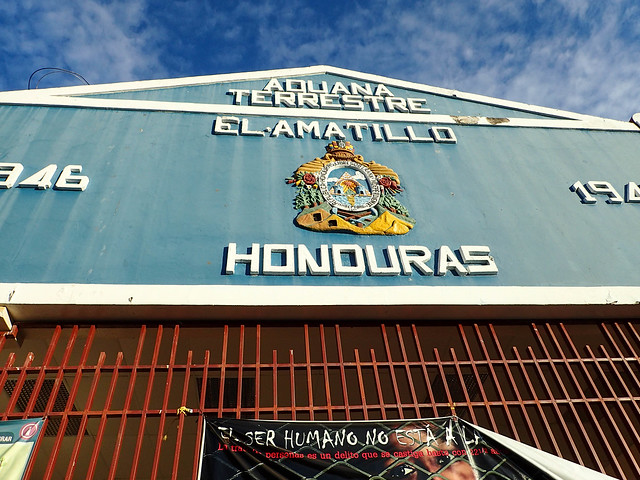
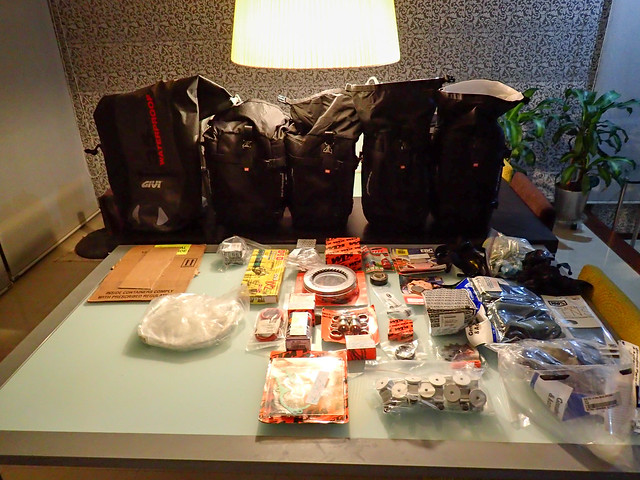


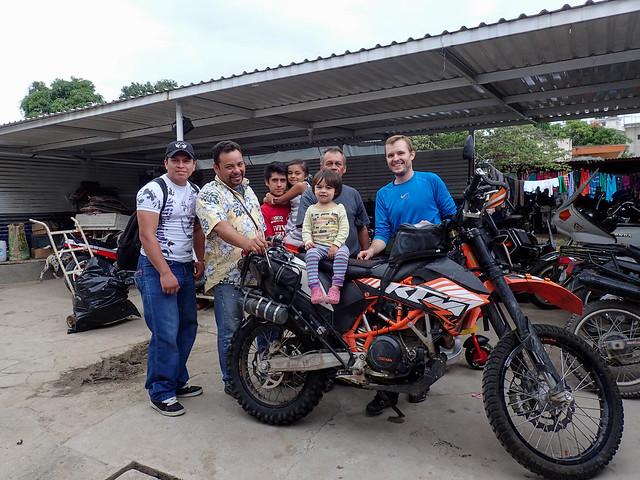

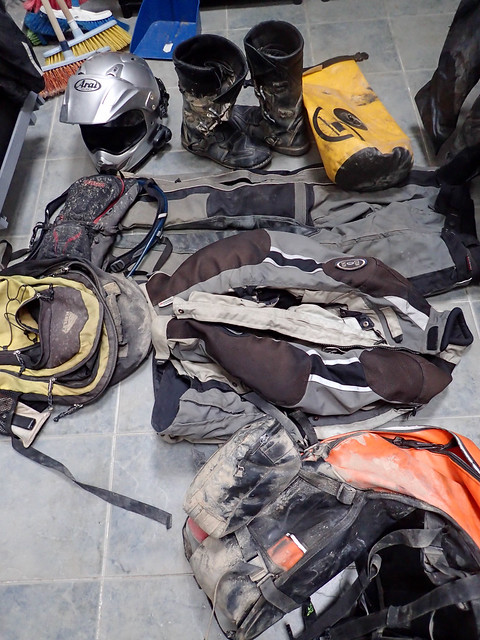
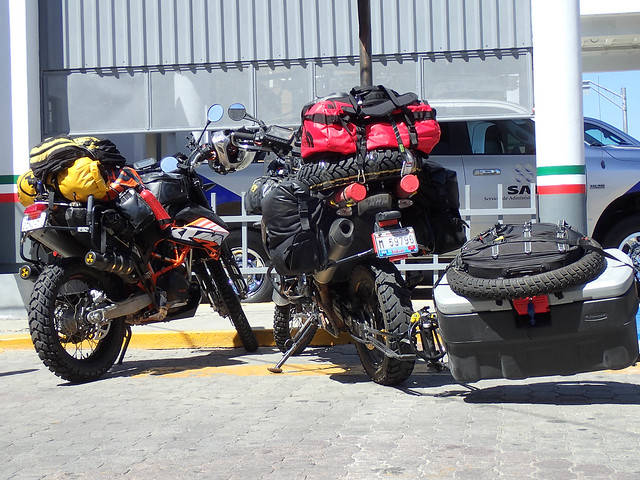
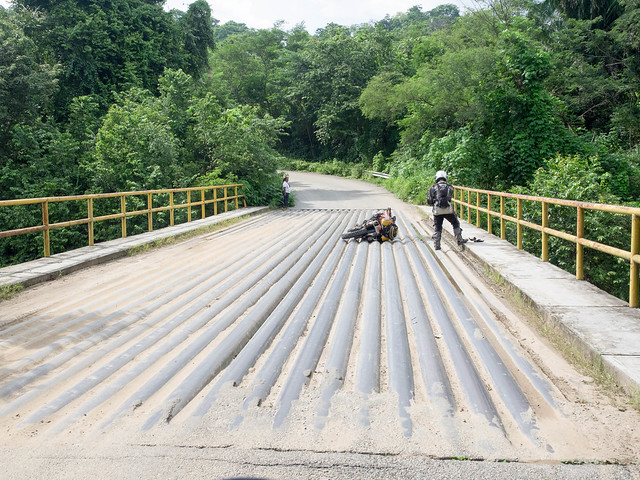
0 comments:
Post a Comment